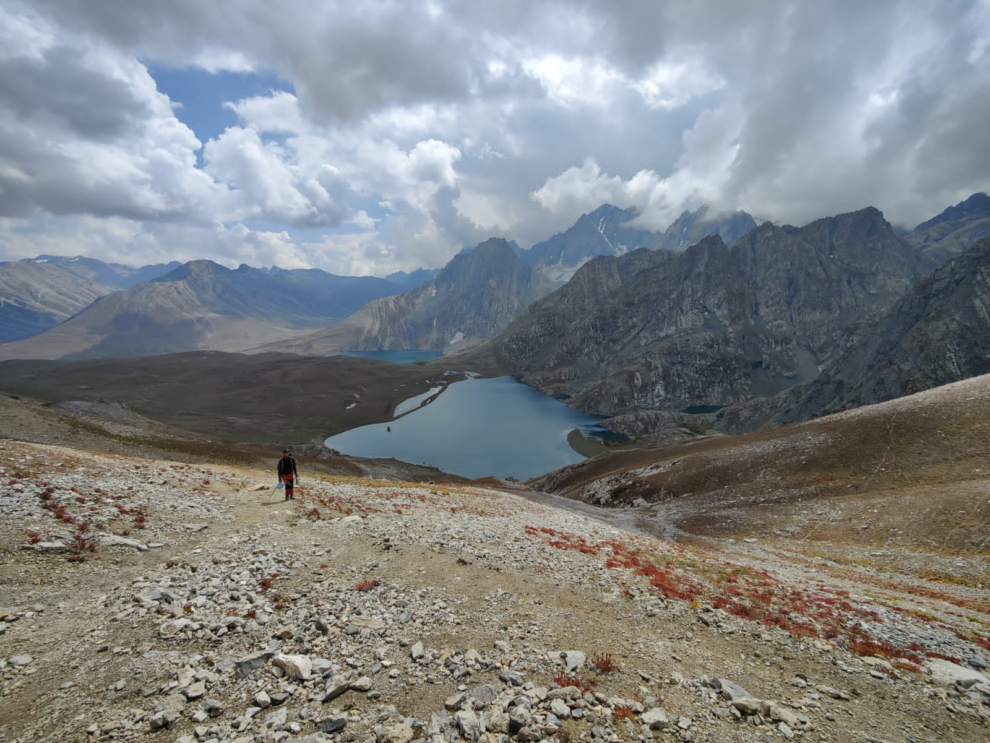Ravi Teja and his four friends were ecstatic when they arrived at Sonmarg on the northern edge of the Kashmir valley. At the point where a roaring stream split the meadows and a wall of mountains towered into clouds, the autumn air was fresh and the vastness, overwhelming.
The surroundings were distinct from the crowded landscape of Teja’s hometown Hyderabad, a southern metropolis and India’s fourth-most populous city. Their journey into the mountains and hundreds of others made by groups of Indian and foreign tourists this year are remarkable.
Kashmir’s densely forested mountains were once forbidden areas and better known as transit routes and hideouts for insurgents. In the early years of the insurgency that began in 1989, at least two major incidents in which foreign trekkers were abducted nearly crippled the tourism sector.
In 1994, British trekkers Kim Housego, 16, and David Mackie, 36, were abducted and later released unharmed after two weeks, while another group of six foreigners was abducted – only one of whom escaped and survived – in July 1995. It was the first time that Teja, 31, and his friends were vacationing in Kashmir, and also their first trek into the mountains, a rigorous seven-day walk with stopovers at the “great lakes”.
These glacial lakes are like large sapphires in the middle of a great wilderness, located at varying altitudes as high as 4,100m. What followed was an adventure that evoked joy, awe and fear. When they were camping at 3,700m on the banks of Kishansar lake, a thunderstorm struck. Teja described it as a nightmare.
“We could feel lightning striking outside our tent,” he said.
These lakes and mountains were forbidden to visitors for much of Kashmir’s recent past, as the region became a theatre of conflict in 1990 that has since ebbed and surged in repeating cycles. An undiscovered mountain paradise Kashmir’s mountains are now being thrown open to trekkers as the government pushes to boost the tourism industry. Nearly 20 million tourists arrived this year in the erstwhile state of Jammu and Kashmir.
As the insurgency waned in the past three years, the administration has been able to open as many as 75 trekking routes, some of which lie close to the de facto border with Pakistan, called the Line of Control. A ceasefire along the de facto border agreed between India and Pakistan in February 2021, and a sharp decline in the number of militants in Kashmir has led to tourism growing rapidly. The opening of these once-forbidden trekking trails is a major policy shift.
“In the last three years, Jammu and Kashmir tourism department has attempted to create an integrated ecosystem,” Lieutenant Governor Manoj Sinha, the head of administration in
Jammu and Kashmir, said at an adventure tourism event in Bangus, a vast meadow near the Line of Control in north Kashmir. Mr Sinha said the local government wanted to “explore the off-beat, unexplored, unseen and unknown natural, traditional, historic and heritage sites” and put Kashmir on the map of global tourism.
“Whether adventure tourists or those who want culinary delight, trekking enthusiasts, lovers of rivers and lakes, those who wish to spend time on quiet mountains, those who want to explore culture and history, or those pilgrims who wish to immerse themselves in holy journeys here, Jammu and Kashmir has an immense wealth to offer,” he said.
Ancient mountain trails
Kashmir, a picturesque Himalayan valley, has been a tourist destination for many centuries. In the 16th century, Mughal monarchs found it a serene getaway from northern India’s blistering summer heat and built a circuit of splendid gardens that have outlived the empires. The latest boom in Kashmir’s tourism sector came in the past two years as the Covid-19 pandemic eased.
“We have been overbooked in the last two years,” said Mudasir Ahmad Malik, owner of the Himalayan Walk trekking company that organised trekking tours for more than 20 groups of Indian and foreign tourists this season.
Malik, 24, fell in love with mountains when he went on his first trek eight years ago. He continued to explore the mountain trails and would guide small groups of tourists who were willing to push their limits. He then completed mountaineering courses and later applied for a government licence.
“When I first went into the mountains, there would be very few people, mostly shepherds, and Indian tourists would rarely go for a trek,” Malik told The National.
Things changed, he said, once the Covid-19 pandemic ended, although restrictions were still in place for international travel. The rush has been unprecedented, he said. Kashmir’s tourism department immediately cashed in on this developing phenomenon in the post-Covid era and worked hard to promote the region as a trekking destination.
“We made significant efforts to promote the culture of trekking … it included the promotion of adventure tourism in every promotional event to create awareness about trekking opportunities in Kashmir,” a high-ranking tourism department official told The National.
The next step was the identification of trails to allow a range of options for beginners and experienced trekkers.
“Our aim is to attract a diverse range of clients in the next few years. This includes foreigners, locals and domestic tourists, thereby expanding the reach of trekking in the region,” the official said.
Mohammad Arif, the founder of adventure travel planner Cliffhangers India, described each trekking expedition as an enormous logistical exercise. His company engages nearly 100 people, including trek guides, assistants and cooks during the core trekking season. He said more tourists are going for treks than ever before.
“Previously people would go trekking, but it was a very limited number. Now there is a huge rush,” he said.
Source: N World
















